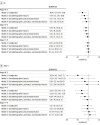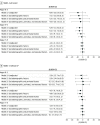Apgar Score and Neurodevelopmental Outcomes at Age 5 Years in Infants Born Extremely Preterm
- PMID: 37672271
- PMCID: PMC10483322
- DOI: 10.1001/jamanetworkopen.2023.32413
Apgar Score and Neurodevelopmental Outcomes at Age 5 Years in Infants Born Extremely Preterm
Abstract
Importance: The Apgar score is used worldwide as an assessment tool to estimate the vitality of newborns in their first minutes of life. Its applicability to estimate neurodevelopmental outcomes in infants born extremely preterm (EPT; <28 weeks' gestation) is not well established.
Objective: To investigate the association between the Apgar score and neurodevelopmental outcomes in infants born EPT.
Design, setting, and participants: This cohort study was conducted using data from the Effective Perinatal Intensive Care in Europe-Screening to Improve Health in Very Preterm Infants in Europe (EPICE-SHIPS) study, a population-based cohort in 19 regions of 11 European countries in 2011 to 2012. Clinical assessments of cognition and motor function at age 5 years were performed in infants born EPT and analyzed in January to July 2023.
Exposures: Apgar score at 5 minutes of life categorized into 4 groups (0-3, 4-6, 7-8, and 9-10 points).
Main outcomes and measures: Cognitive and motor outcomes were assessed using the Wechsler Preschool and Primary Scale of Intelligence test of IQ derived from locally normed versions by country and the Movement Assessment Battery for Children-Second Edition. Parents additionally provided information on communication and problem-solving skills using the Ages and Stages Questionnaire, third edition (ASQ-3). All outcomes were measured as continuous variables.
Results: From the total cohort of 4395 infants born EPT, 2522 infants were live born, 1654 infants survived to age 5 years, and 996 infants (478 females [48.0%]) followed up had at least 1 of 3 outcome measures. After adjusting for sociodemographic variables, perinatal factors, and severe neonatal morbidities, there was no association of Apgar score with IQ, even for scores of 3 or less (β = -3.3; 95% CI, -10.5 to 3.8) compared with the score 9 to 10 category. Similarly, no association was found for ASQ-3 (β = -2.1; 95% CI, -24.6 to 20.4). Congruent results for Apgar scores of 3 or less were obtained for motor function scores for all children (β = -4.0; 95% CI, -20.1 to 12.1) and excluding children with a diagnosis of cerebral palsy (β = 0.8, 95% CI -11.7 to 13.3).
Conclusions and relevance: This study found that low Apgar scores were not associated with longer-term outcomes in infants born EPT. This finding may be associated with high interobserver variability in Apgar scoring, reduced vitality signs and poorer responses to resuscitation after birth among infants born EPT, and the association of more deleterious exposures in the neonatal intensive care unit or of socioeconomic factors with greater changes in outcomes during the first 5 years of life.
Conflict of interest statement
Figures



References
-
- Razaz N, Cnattingius S, Persson M, Tedroff K, Lisonkova S, Joseph KS. One-minute and five-minute Apgar scores and child developmental health at 5 years of age: a population-based cohort study in British Columbia, Canada. BMJ Open. 2019;9(5):e027655. doi:10.1136/bmjopen-2018-027655 - DOI - PMC - PubMed

